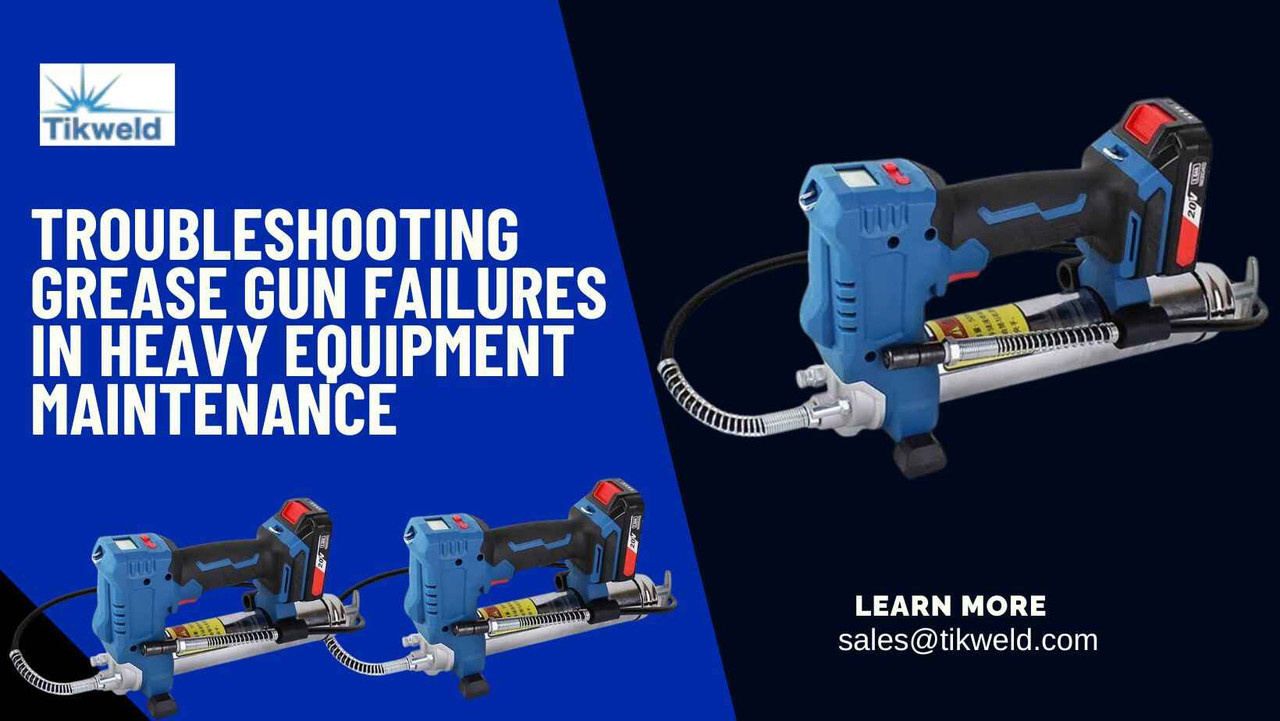Troubleshooting Grease Gun Failures in Heavy Equipment Maintenance
Introduction
Heavy equipment like bulldozers, excavators, and industrial loaders require consistent lubrication to function efficiently. Grease guns play a vital role in this maintenance routine by delivering lubricant precisely where it’s needed. However, when these grease guns malfunction, the result can be costly downtime and accelerated wear on equipment components.
In this article, we explore the most common grease gun failures in heavy-duty environments and provide practical troubleshooting tips to keep your maintenance operations smooth and effective.
Read more...Types of Grease to Use on a Grease Gun
Key Takeaway
- Routine Maintenance Prevents Failures Clean and store grease guns properly, inspect for wear, and ensure all parts are functioning. Preventative maintenance extends tool life and supports consistent lubrication.
- Train Maintenance Personnel Operators and technicians should be trained on proper grease gun handling, maintenance practices, and troubleshooting steps to minimize downtime and ensure optimal equipment health.
- Keep Spare Parts and Kits Handy Stocking rebuild kits, replacement couplers, seals, and cleaning tools helps address failures promptly and reduces maintenance delays.
Why Grease Guns Are Critical for Heavy Equipment Maintenance
Grease guns ensure that moving parts are well-lubricated to prevent:
- Friction and heat buildup, which can damage components
- Seal and bearing failure, especially in hydraulic systems
- Costly repairs and unplanned maintenance downtime
In rugged industrial settings, reliability of the grease gun becomes as important as the lubricant itself. When the tool fails, so does the equipment it supports.
Common Grease Gun Problems
Below are typical issues faced in field operations:
Grease Gun Not Dispensing Grease
Possible Causes:
- Air pockets in the cartridge
- Blocked or dried-up grease in the nozzle
- Improper loading of grease
Quick Fix:
- Bleed air via the release valve (if present)
- Re-prime the grease gun
- Refer to our guide on loading a grease gun efficiently to avoid this in the future.
Grease Gun Leaking at Nozzle or Fittings
Possible Causes:
- Worn-out coupler or damaged seal
- Over-pressurization
- Misalignment with the grease fitting
Solution:
- Replace or upgrade to a high-quality grease coupler
- Clean the connection point before use
- Check pressure output settings if using pneumatic or battery-powered grease gun
Grease Gun Losing Pressure
Possible Causes:
- Worn-out seals or plunger components
- Air leaks in the chamber
- Grease too thick for current temperature conditions
Solution:
- Replace seals and inspect O-rings regularly
- Ensure all joints and connections are tight
- Use grease suited for ambient temperature ranges or warm the grease gun slightly in cold environments
Clogged Fittings and Grease Blockage
- Possible Causes:
- Hardened grease at the tip or inside the fitting
- Contamination entering the grease system
- Improper or expired grease used
Solution:
- Clean fittings with a wire brush before each application
- Use a pin or fitting cleaning tool to dislodge blockages
- Store grease cartridges in a clean, dry environment
Read more...How to Load a Grease Gun Without a Mess
Maintenance and Prevention Strategies
Routine Grease Gun Checks
- Inspect for cracks, leaks, and worn-out components weekly
- Always prime your grease gun correctly before use
Use the Right Grease for the Right Job
Refer to our backlink article types of grease for industrial guns for guidelines on choosing suitable grease types for heavy-duty machinery.
Label and Rotate Grease
To avoid contamination or mixing incompatible greases, always label cartridges and avoid mixing different types in one gun
Store Correctly
- Store grease guns in upright positions
- Clean the nozzle before and after use
- Keep in a dust-free area to prevent clogging
Comparison Table: Grease Guns for Heavy Equipment Maintenance

Frequently Asked Questions
1. Why does my grease gun work one day and fail the next?
Intermittent issues are often due to air pockets or inconsistent priming. Always purge air and inspect seals before use.
2. How do I know if my grease gun is pushing enough grease?
Look for movement in mechanical components or listen for resistance. You may also consider adding a grease pressure indicator to fittings.
3. Can I mix different grease types in the same gun?
No. Mixing incompatible greases can lead to separation, hardening, or lubrication failure. Always finish a cartridge before switching.
4. What’s the best way to keep grease guns functional during long-term storage?
Clean the nozzle, relieve pressure, and store vertically in a dust-free environment. Label for easy identification.
Related Article
Common Grease Gun Problems and How to Fix Them
Manual vs Pneumatic vs Battery-Powered Grease Guns: Which Is Best for You?
Conclusion
In the heavy equipment world, a malfunctioning grease gun isn’t just an inconvenience—it can lead to costly delays, increased wear, and preventable repairs. By identifying common issues early and practicing routine maintenance, you can maximize equipment uptime and reduce manual labor frustration.
From pressure loss and clogged fittings to grease leakage and plunger issues, troubleshooting your grease gun is a vital part of a technician's skill set. Need quality grease guns or replacement parts? Visit Tikweld Welding Supplies to explore our wide range of reliable lubrication tools and keep your equipment running smoothly.







